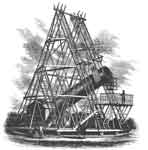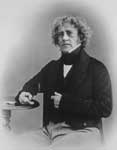Sir Frederick William Herschel, FRS KH (15 November 1738 – 25 August 1822) was a German-born British astronomer and composer who became famous for discovering Uranus. He also discovered infrared radiation and made many other discoveries in astronomy.
Early life and musical activities
He was born Friedrich Wilhelm Herschel in Hanover, Germany, as one of ten children (of whom four died very young), of Isaac Herschel (1707-1768) an oboist of the Hanover Military Band. Although Isaac was of Jewish birth [1], his wife was a Christian and the children were raised as Christians. His wife especially was instrumental in his own conversion to Christianity. In 1755 the Hanoverian Guards regiment, in whose band William and his brother Jacob were engaged as oboists, was ordered to England. At the time, the crowns of England and Hannover were united under George II. This brief visit made an impression, and the next year the brothers resigned from the Guards band and moved to London. William learned English quickly and, at age nineteen, he changed his name to Frederick William Herschel.
He became a successful music teacher and bandleader, played the violin besides the oboe and, later, the organ. During a concert in 1767, Herschel showed off his versatility by performing an oboe concerto, violin concerto and harpsichord sonata. He composed numerous musical works, including 24 symphonies and many concertos, as well as some church music. Besides a few oboe concertos, his music is largely forgotten today. After a career leading orchestras in Newcastle, Leeds and Halifax (he was organist at the Parish Church of St John the Baptist, Halifax, West Yorkshire), he became organist of the Octagon Chapel, Bath, in which town he was also Director of Public Concerts. His sister Caroline came to England in 1772 and lived with him there in New King Street. His brothers Dietrich, Alexander and Jacob (1734-1792) also appeared as musicians of Bath. In 1780, Herschel was appointed director of the Bath orchestra, with his sister often appearing as soprano soloist.
Astronomy
Discoverer of Uranus
| Uranus | 13 March 1781 |
Herschel's music led him to an interest in mathematics, and thence to astronomy. This interest grew stronger after 1773, and he built some telescopes and made the acquaintance of Nevil Maskelyne. He observed the Moon, measuring the heights of lunar mountains, and also worked on a catalog of double stars.
| Oberon | 11 January 1787 |
| Titania | 11 January 1787 |
| Enceladus | 28 August 1789 |
| Mimas | 17 September 1789 |
The turning point in Herschel's life was 13 March 1781, while he was living at 19 New King Street, Bath, (now the Herschel Museum of Astronomy) when he made the first sighting of the planet Uranus. This made him famous and enabled him to turn to astronomy full-time. Naming the new planet Georgium Sidus, Latin for "George's Star", in honour of King George III also brought him favour (the name didn't stick - in France, where reference to the British king was to be avoided if possible, the planet was known as 'Herschel' until the name 'Uranus' was universally adopted). That same year, Herschel was awarded the Copley Medal and was elected a Fellow of the Royal Society. In 1782, he was appointed "The King’s Astronomer" and he and his sister subsequently moved to Datchet (then in Buckinghamshire but now in Berkshire) on 1 August 1782. He continued his work as a telescope maker, selling a number of them to other astronomers.
Work with his sister Caroline
In 1783 he gave Caroline a telescope and she began to make astronomical discoveries in her own right, particularly comets. Caroline also served as his full-time assistant, taking notes while he observed at the telescope.
In June 1785, owing to damp conditions, he and Caroline moved to Clay Hall in Old Windsor. Clay Hall (or Clayhall Farm) had been owned by Samuel Foote, father of Topham Foote whose bust by Peter Scheemakers is in Windsor Parish Church. Topham's mother sold the farm to her brother Richard Topham who willed it to Sidney Bleuclerk. On 3 April 1786, William Herschel moved his family to a new residence on Windsor Road in Slough. He lived the rest of his life in this residence, which came to be known as Observatory House. It is no longer standing, having been demolished in 1963 to make way for a high-rise office building.
On 7 May 1788, he married the widow Mary Pitt (née Baldwin) at St Laurence's Church, Upton in Slough. His sister Caroline then moved to separate lodgings, but continued to work as his assistant.
Herschel's telescopes
During the course of his career, he constructed more than four hundred telescopes. The largest and most famous of these was a reflecting telescope with a 40 ft (12 m) focal length and an aperture 49½ inches (126 cm) in diameter. On 28 August 1789, his first night of observation using this instrument, he discovered a new moon of Saturn. A second moon followed within the first month of observation. The 40 ft (12 m) telescope proved very cumbersome, however, and most of his observations were done with a smaller telescope of 20 ft (6.1 m) focal length. Herschel discovered that unfilled telescope apertures can be used to obtain high angular resolution, something which became the essential basis for interferometric imaging in astronomy (in particular Aperture Masking Interferometry and hypertelescopes).
Further discoveries
In his later career, Herschel discovered two moons of Saturn, Mimas and Enceladus; as well as two moons of Uranus, Titania and Oberon. He did not give these moons their names; rather, they were named by his son John in 1847 and 1852, respectively, well after his death.
He worked on creating an extensive catalog of nebulae. He continued to work on double stars, and was the first to discover that most double stars are not mere optical doubles as had been supposed previously, but are true binary stars, thus providing the first proof that Newton's laws of gravitation apply outside the solar system.
From studying the proper motion of stars, he was the first to realize that the solar system is moving through space, and he determined the approximate direction of that movement. He also studied the structure of the Milky Way and concluded that it was in the shape of a disk.
He also coined the word "asteroid", meaning star-like (from the Greek asteroeides, aster "star" + -eidos "form, shape"), in 1802 (shortly after Olbers discovered the second minor planet, 2 Pallas, in late March of the same year), to describe the star-like appearance of the small moons of the giant planets and of the minor planets; the planets all show discs, by comparison.
Despite his numerous important scientific discoveries, Herschel was not averse to wild speculation. In particular, he believed every planet was inhabited[2], even the Sun: he believed that the Sun had a cool, solid surface protected from its hot atmosphere by an opaque layer of cloud, and that a race of beings adapted to their strange environment lived there and had enormous heads.[citation needed]
Discovery of infrared radiation
Herschel discovered infrared radiation by passing sunlight through a prism and holding a thermometer just beyond the red end of the visible spectrum. This thermometer was meant to be a control to measure the ambient air temperature in the room. He was shocked when it showed a higher temperature than the visible spectrum. Further experimentation led to Herschel's conclusion that there must be an invisible form of light beyond the visible spectrum.
Family and death
William and Mary had one child, John, born at Observatory House on 7 March 1792. In 1816, William was made a Knight of the Royal Guelphic Order by the Prince Regent entitling him to the prefix 'Sir'. He helped to found the Astronomical Society of London in 1820, which in 1831 received a royal charter and became the Royal Astronomical Society.
On 25 August 1822, Herschel died at Observatory House, Slough, and is buried at nearby St Laurence's Church, Upton.
His son John Herschel also became a famous astronomer. One of William's brothers, Alexander Herschel, moved permanently to England, near Caroline and John.
His house at 19 New King Street in Bath, Somerset where he made many telescopes and first observed Uranus, is now home to the Herschel Museum of Astronomy.
Named after Herschel
* Mu Cephei, Two of the largest known stars in the universe, is also known as Herschel's Garnet Star
* Herschel, a small crater on the Moon
* Herschel, a large impact basin on Mars
* The enormous Herschel crater on Saturn's moon Mimas
* 2000 Herschel, an asteroid
* The William Herschel Telescope on La Palma
* The Herschel Space Observatory, currently under development by the European Space Agency. It will be the largest space telescope of its kind
* Herschel Grammar School, Slough
* Rue Herschel, a street in Paris, France bears his name.
* The Herschel Building at Newcastle University, Newcastle, United Kingdom
* Herschel Museum of Astronomy
* Herschel School, Cape Town, a private girl's school
* Herschelschule, Hannover, Germany, a grammar school
* Herschel, Saskatchewan, Canada is a small, rural village that is home to the Ancient Echoes Interpretive Centre
* The Herschel Observatory, from the school Universitas in Santos, Brazil.
* The lunar crater C. Herschel, the asteroid 281 Lucretia, and the comet 35P/Herschel-Rigollet are named after his sister Caroline Herschel.
See also
The Georgian Star: how William and Caroline Herschel invented modern astronomy
Notes
1. ^ His father, Abraham, was a member of the Hanover Jewish community. See H.Geduld, Jewish World Review, April 24, 1998. - also here. In addition see article in Jewish Encyclopaedia
2. ^ [The idea of life on our neighbour planet [Mars] has inspired humans for a long time. The British royal astronom Astronom Sir William Herschel (1738-1822) assumed that there are intelligent beings not only on Mars, but on all planets in our solar system (see http://science.orf.at/science/news/86466)
References
* Biography: JRASC 74 (1980) 134
* "William Herschel"by Michael Hoskin. New dictionary of Scientific Biography Scribners, 2008. v. 3, pp. 289-291.
Retrieved from "http://en.wikipedia.org/"
All text is available under the terms of the GNU Free Documentation License




